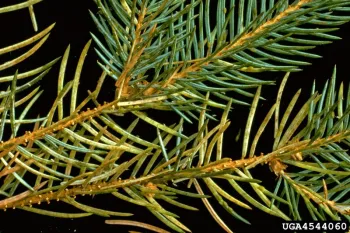Trees Affected 

Common: Spruces, including Sitka Spruce
Occasional*: True Firs, Siberian Larch, Eastern White Pine, Scotch Pine, Douglas Fir
*Only during outbreaks
Summary
The green spruce aphid is a small (1-2mm), green insect with reddish eyes that feeds primarily on the needles of spruce trees. These invasive sap suckers cause marked defoliation, stunted growth, and occasionally, full tree mortality. Although this aphid is present on their host tree throughout the year, they are most active during the late winter and early spring, before most native aphid parasites are present. Infestations are often only detected when the affected needles drop, after the majority of the damage is done. The aphids generally feed on older needles, so one sign of this pest is defoliation of all but the current season’s needles. On younger trees (< 5 years), the aphids primarily feed on the upper canopy, while in older trees they attack shaded areas, which are generally on the lower portion of the tree. Like many aphids, the green spruce aphid produces honeydew, which facilitates the growth of a sooty mold on the host tree. Although the presence of sooty mold is not a definitive sign of green spruce aphid in particular, it is a good indicator of a potential aphid infestation. Shaking affected foliage over a piece of white paper to see if green aphids fall onto it is a common method of detection.
Local Distribution
The local distribution of this insect is unknown, but appears to be widespread. Trees with symptoms consistent to those produced by green spruce aphids have been found along Highway 101 between Fortuna and Orick, as well as along roads throughout coastal Humboldt County.
Management Strategies

Pests and Pathogens with Similar Symptoms
Giant Conifer Aphids (Cinara spp.): Aphids in this genus feed on sap from roots, twigs, and branches of various conifer species. Although they are aphids and share a basic body plan, they are much larger than green spruce aphids (5-6 mm in length) and dark brown or black instead of green. They are also frequently mistaken for ticks, so if your aphid looks like a tick, it’s likely a giant conifer aphid and not a green spruce aphid.
Further Reading
Description with distribution map, aphid biology, and management strategies
Description of the Green Spruce aphid. Note that risk and management sections are written for a European setting and may not be accurate to local forests and conditions
